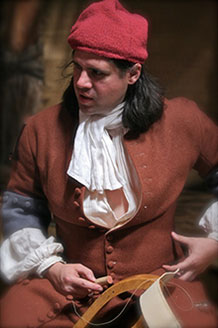About
- Introduction
- Methodology
- Previous Work
- National Battlefields Commission, Quebec City
- Soldier’s Uniform for the Carignan-Salières Regiment
- Leather and Wood Powder Flasks
- French Bayonet Scabbards
Introduction
At the Royal Sword is a small business offering reproductions of French objects from the first half of the 18th century. These reproductions will satisfy the most demanding customers. David Ledoyen operates this business, known in French as À l’Épée Royale.
David Ledoyen is from Montréal, Québec, Canada. Since childhood he is recognized as a "history buff" and he is fascinated by the idea of presenting history through reconstructed objects. Inspired by television programs, readings and visits at museums, his first endeavors involved ordinary materials within the reach of a schoolboy (cardboard, wood, etc.)
In the mid-1990s, his interest for New France was confirmed when he worked as a heritage interpreter at Fort-Chambly, a major historical landmark of the French colonial era. There, he met the passionate re-enactors of the Société de reconstitution historique du Québec (SRHQ). In 1999, he joined the group, founded by André Gousse. David Ledoyen now belongs to the Détachement de la colonie, a Québec re-enactment group representing a small detachment of soldiers from the compagnies franches de la Marine during the Seven Years War (the last French and Indian War in North America, 1756-1763).
As he tried to portray accurately a French soldier, David Ledoyen experienced frustration: aside from a few flintlock models and Collection Nouvelle-France's pottery, there were almost no quality reproductions of French objects of the first half of the 18th century available on the market. It was the search for a simple — but authentic — French pewter spoon that started David on a long journey. It included various experiments, visits of archaeological collections, multiple quests for out-of-print books and reports, meetings with many historians, material culture specialists and skillful craftsmen. Discovery and passion are always to be experienced along this trail and many of David’s encounters evolved into lasting friendships.
The products offered through this Website are the result of this decade of study and labor. Many re-enactors in North America already benefit from this work, as well as some museums.
Methodology
The objects made by David Ledoyen or under his supervision must satisfy the well-versed aficionados. Reproductions must meet high standards of accuracy when compared to original models. These standards can only be set through the methodical comparison of period documents, objects from the historical and archaeological collections and the most up-to-date research publications.
After a type of object has been selected for its historical relevance, original specimens are used as models for reproduction purpose. Some of our spoons are cast in original molds or reproduced from antiques. The hilts of our swords are all made from castings of original parts. As you know, these original 18th century parts are hard to obtain. The quest for quality has its price but is also very rewarding.
Previous Work
David Ledoyen has contributed to some museum exhibits He not only supplied objects but also acted as consultant on the exhibit’s theme or offered new perspectives. Here is some of his previous works:
Exhibit “Reviewing the troops”
National Battlefields Commission (NBC), Quebec City, Québec, Canada
http://www.ccbn-nbc.gc.ca/_en/odyssecanada.php
In 2003, the NBC launched a new exhibit, highlighting the uniforms of French and British soldiers who fought at the Battles of the Plains of Abraham (1759) and Sainte-Foy (1760), as well as their daily life. For this exhibit, David Ledoyen made all the French accoutrements, including a drummer’s sling and waistbelt decorated with the King’s livery lace, a shoulder box for a French artilleryman, and a waistbelt covered with velvet and gold lace for the General Montcalm mannequin. He also found many original or reproduction objects to illustrate the daily life in the 1759 military camps.
Complete Uniform, Accoutrements and Weapons for a Soldier of the Carignan-Salières Regiment.
Fort Saint-Jean Museum, Saint-Jean-sur-Richelieu, Québec, Canada
http://www.museedufortsaintjean.ca/
This museum is located on the grounds of the Royal Military College of Canada in Saint-Jean-sur-Richelieu. The College is located on the site of a series of colonial French and British forts. The first of these forts, Fort L’Assomption, was built by the famous Carignan-Salières Regiment in 1666. In 2009, the museum required a new life-size mannequin that would represent this unit. David Ledoyen oversaw the production of the uniform and weapons. He made the buff leather baldric and bandolier.
Powder flasks, boiled leather on wood shell, 2009
David Ledoyen made 24 of these flasks reproduced from an original. The inner wood shell is covered in boiled leather which is leather hardened in hot wax. Spouts were turned in boxwood and have threads to screw them in the flask’s neck.
French bayonet scabbards, model 1750
These scabbards were made in 2008 using a 1750 document, specimens from European collections and archaeological artifacts from Fort Carillon (Ticonderoga, New York). David Ledoyen made the wood liner and covered it with black calf leather. Steve Delisle skillfully made the iron furnishings.

